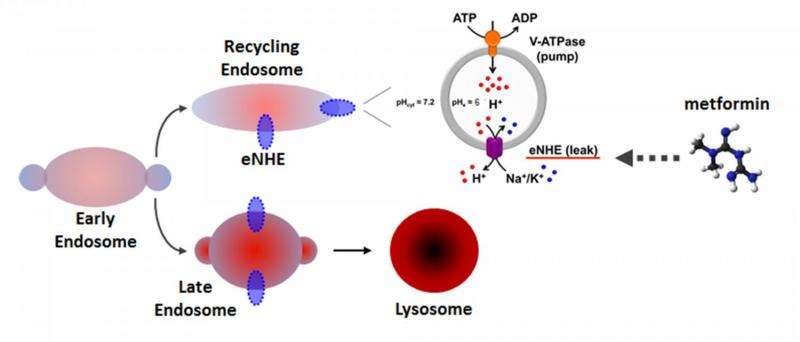Novel target for diabetes drug identified as ion exchanger

Nagoya University-led researchers use nematode worms as a model to identify a new target of the type 2 diabetes drug metformin; ion exchanger protein NHX-5 and its related protein in fruit flies are potential metformin targets, suggesting the drug controls the cellular endocytic cycle.
The most common type of diabetes, type 2, is characterized by insulin resistance and high blood glucose. Many patients are prescribed metformin, an anti-diabetic drug known to decrease hepatic glucose production and increase its uptake by muscle. Metformin also shows positive effects on other diseases such as polycystic ovary syndrome, nerve disorders, and some cancers. These versatile effects suggest that metformin could target multiple molecules, although details of its targets have remained unclear. A research team led by Nagoya University has now identified a novel potential target, a protein that mediates the exchange of sodium and hydrogen ions, using the model nematode Caenorhabditis elegans. The study was reported in the Journal of Biological Chemistry.
This latest study found that metformin reduces L1 longevity, a survival response to starvation of the first larval stage, in C. elegans. A genetic screen identified a mutant worm resistant to metformin's action. The mutation was mapped to the endosomal sodium/hydrogen exchanger protein NHX-5, suggesting it could be used as a potential target.
The fruit fly Drosophila is another model organism that researchers commonly use, and it was previously shown that metformin treatment reduces the lifespan of flies. In this study, the researchers tested mutant flies lacking NHE3, which is the homologous protein (one sharing an evolutionary history) to NHX-5 in Drosophila. They showed that NHE3 mutant flies are completely resistant to metformin. This result suggests that NHE is also the target of metformin in flies and that NHE may be a conserved target of metformin in other species.
NHX-5 is expressed in many parts of C. elegans, including the intestine and neurons. In the cell, it exists in the membranes of cellular components known as endosomes. Endosomes transport molecules such as proteins through a pathway that enables the sorted proteins to be secreted, recycled, or degraded. Treatment of C. elegans with metformin was shown to prevent formation of related cellular components known as autophagosomes, which are structures that break down cellular material, particularly during periods of starvation as a means of obtaining energy.
Metformin also reduced the oxygen consumption rate of C. elegans, hinting it may inhibit the function of mitochondria (cellular metabolic energy generators), as seen in mammals. "These findings suggest metformin targets NHX-5 to disrupt autophagy and related subcellular processes during L1 starvation in C. elegans, so that less energy is available," corresponding author Young-Jai You says. "This ultimately reduces L1 longevity, and supports a link between mitochondria and the endocytic cycle that is controlled by NHX-5."
More information: Jeongho Kim et al. NHX-5, an Endosomal Na/HExchanger, Is Associated with Metformin Action, Journal of Biological Chemistry (2016). DOI: 10.1074/jbc.C116.744037
Journal information: Journal of Biological Chemistry
Provided by Nagoya University



















